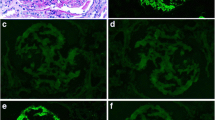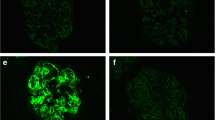Abstract
Background
Proliferative glomerulonephritis with monoclonal IgG deposits (PGNMID) is a glomerular disease defined by non-organized glomerular deposits of heavy and light chain–restricted immunoglobulin and is rarely reported in children.
Methods
We characterized a series of nine pediatric patients from two academic centers with biopsy-proven PGNMID and additionally describe two patients with monotypic IgG in the setting of IgM deposition.
Results
Each patient presented with hematuria and/or proteinuria; however, only five had elevated serum creatinine. Prodromal or concurrent infection was identified in six patients, low C3 in five, and alternate complement pathway gene variants in two. No monoclonal serum proteins were identified in five tested patients. Seven patients had monotypic deposits composed of IgG3-λ, two showed IgG3-κ, and one each IgG1 and IgG3 with lambda dominance in the setting of IgM deposition. The glomerular pattern was predominantly mesangial proliferative or membranoproliferative glomerulonephritis (MPGN). Treatment and outcomes were variable; four patients have recent PGNMID diagnoses and therefore minimal follow up, one had relatively stable kidney function for over a decade, and six experienced kidney failure, with four receiving transplants. Recurrent deposits of the same isotype were identified in five of six transplanted kidneys, corresponding to three of four transplanted patients. One of these patients developed PGNMID recurrences in three separate kidney allografts over a 20-year disease course.
Conclusions
Our study emphasizes the need for upfront IgG subclass investigation in pediatric mesangial or MPGN with IgG deposition and monotypic or biased light-chain staining. Furthermore, this pediatric experience suggests expanded pathogenic considerations in PGNMID.

Graphical abstract



Similar content being viewed by others
Data availability
Detailed histopathologic data from all biopsies are provided as supplementary table (online resource 1).
References
Nasr SH, Markowitz GS, Stokes MB, Seshan SV, Valderrama E, Appel GB, Aucouturier P, D'Agati VD (2004) Proliferative glomerulonephritis with monoclonal IgG deposits: a distinct entity mimicking immune-comple glomerulonephritis. Kidney Int 65:85–96. https://doi.org/10.1111/j.1523-1755.2004.00365.x
Nasr SH, Satoskar A, Markowitz GS, Valeri AM, Appel GB, Stokes MB, Nadasdy T, D'Agati VD (2009) Proliferative glomerulonephritis with monoclonal IgG deposits. J Am Soc Nephrol 20:2055–2064. https://doi.org/10.1681/asn.2009010110
Said SM, Cosio FG, Valeri AM, Leung N, Sethi S, Salameh H, Cornell LD, Fidler ME, Alexander MP, Fervenza FC, Drosou ME, Zhang D, D'Agati VD, Nasr SH (2018) Proliferative glomerulonephritis with monoclonal immunoglobulin G deposits is associated with high rate of early recurrence in the allograft. Kidney Int 94:159–169. https://doi.org/10.1016/j.kint.2018.01.028
Xing G, Gillespie R, Bedri B, Quan A, Zhang P, Zhou XJ (2018) Proliferative glomerulonephritis with monoclonal IgG deposits in children and young adults. Pediatr Nephrol 33:1531–1538. https://doi.org/10.1007/s00467-018-3949-8
Torrealba J, Gattineni J, Hendricks AR (2018) Proliferative glomerulonephritis with monoclonal immunoglobulin G lambda deposits: report of the first pediatric case. Case Rep Nephrol Dial 8:70–75. https://doi.org/10.1159/000488641
Leung N, Bridoux F, Batuman V, Chaidos A, Cockwell P, D'Agati VD, Dispenzieri A, Fervenza FC, Fermand J-P, Gibbs S, Gillmore JD, Herrera GA, Jaccard A, Jevremovic D, Kastritis E, Kukreti V, Kyle RA, Lachmann HJ, Larsen CP, Ludwig H, Markowitz GS, Merlini G, Mollee P, Picken MM, Rajkumar VS, Royal V, Sanders PW, Sethi S, Venner CP, Voorhees PM, Wechalekar AD, Weiss BM, Nasr SH (2019) The evaluation of monoclonal gammopathy of renal significance: a consensus report of the international kidney and monoclonal gammopathy research group. Nat Rev Nephrol 15:45–59. https://doi.org/10.1038/s41581-018-0077-4
Hemminger J, Nadasdy G, Satoskar A, Brodsky SV, Nadasdy T (2016) IgG subclass staining in routine renal biopsy material. Am J Surg Pathol 40:617–626. https://doi.org/10.1097/pas.0000000000000605
Davis CW, Boyd SD, Ahmed R (2019) Longitudinal analysis of the human B cell response to Ebola virus infection. Cell 177:1566–1582. https://doi.org/10.1016/j.cell.2019.04.036
Fujita E, Shimizu A, Kaneko T, Masuda Y, Ishihara C, Mii A, Higo S, Kajimoto Y, Kanzaki G, Nagasaka S, Iino Y, Katayama Y, Fukuda Y (2012) Proliferative glomerulonephritis with monoclonal immunoglobulin G3κ deposits in association with parvovirus B19 infection. Hum Pathol 43:2326–2333. https://doi.org/10.1016/j.humpath.2012.04.004
Takehara E, Mandai S, Shikuma S, Akita W, Chiga M, Mori T, Oda T, Kuwahara M, Uchida S (2017) Post-infectious proliferative glomerulonephritis with monoclonal immunoglobulin G deposits associated with complement factor H mutation. Intern Med 56:811–817. https://doi.org/10.2169/internalmedicine.56.7778
Zhang F, Gao E, Liang S, Yang N, Wang J (2018) A case of switch from C3 glomerulonephritis to proliferative glomerulonephritis with monoclonal IgG deposits. Ann Clin Lab Sci 48:528–533 0091-7370/18/0400-528
Guiard E, Karras A, Plaisier E, Van Huyen J-PD, Fakhouri F, Rougier J-P, Noel L-H, Callard P, Delahousse M, Ronco P (2011) Patterns of Noncryoglobulinemic glomerulonephritis with monoclonal Ig deposits: correlation with IgG subclass and response to rituximab. Clin J Am Soc Nephrol 6:1609–1616. https://doi.org/10.2215/cjn.10611110
Larsen C, Boils C, Cossey L, Sharma S, Walker P (2016) Clinicopathologic features of membranous-like glomerulopathy with masked IgG kappa deposits. Kidney Int Rep 1:299–305. https://doi.org/10.1016/j.ekir.2016.08.012
Gumber R, Cohen JB, Palmer MB, Kobrin SM, Vogl DT, Wasserstein AG, Nasta SD, Bleicher MB, Bloom RD, Dember L, Cohen A, Weiss BM, Hogan JJ (2018) A clone-directed approach may improve diagnosis and treatment of proliferative glomerulonephritis with monoclonal immunoglobulin deposits. Kidney Int 94:199–205. https://doi.org/10.1016/j.kint.2018.02.020
Katsuno T, Kato M, Fujita T, Tsuboi N, Hattori R, Ito Y, Maruyama S (2019) Chronological change of renal pathological findings in the proliferative glomerulonephritis with monoclonal IgG deposits considered to have recurred early after kidney transplantation. CEN Case Rep 8:151–158. https://doi.org/10.1007/s13730-019-00384-6
Author information
Authors and Affiliations
Contributions
Megan Troxell, Neeraja Kambham, Colin Lenihan, and Cynthia Nast contributed to the study conception and design. All the authors contributed to the data collection. Data tabulation and analysis was performed by Paul Miller, Andrew Xiao, Vanderlene Kung, and Megan Troxell. The first draft of the manuscript was written by Paul Miller, Andrew Xiao, and Megan Troxell. All the authors commented on previous versions of the manuscript. All the authors read and approved the final manuscript.
Corresponding author
Ethics declarations
Conflict of interest
Dr. Amanda Uber is a Paul and Yuanbi Ramsay Endowed Fellow, Maternal and Child Health Research Institute at Stanford.
None of the other authors have conflicts of interest to declare.
Ethics approval
This study received Institutional Review Board approval at Stanford and Cedars-Sinai, and was performed in accordance with the ethical standards as laid down in the 1964 Declaration of Helsinki and its later amendments or comparable ethical standards.
Consent to participate
Not applicable (HIPAA waiver for retrospective study).
Consent for publication
Not applicable (HIPAA waiver for retrospective study).
Additional information
Publisher’s note
Springer Nature remains neutral with regard to jurisdictional claims in published maps and institutional affiliations.
Rights and permissions
About this article
Cite this article
Miller, P., Xiao, A.Y., Kung, V.L. et al. Progression of proliferative glomerulonephritis with monoclonal IgG deposits in pediatric patients. Pediatr Nephrol 36, 927–937 (2021). https://doi.org/10.1007/s00467-020-04763-5
Received:
Revised:
Accepted:
Published:
Issue Date:
DOI: https://doi.org/10.1007/s00467-020-04763-5




